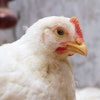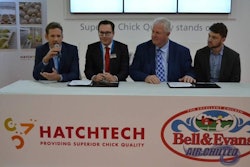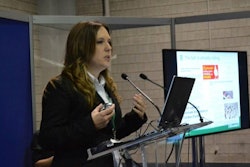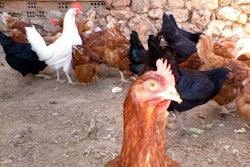“Where there’s muck, there’s brass,” is a phrase usually more associated with the U.K. county of Yorkshire than Norfolk, and while one of the U.K.’s largest broiler producers has discovered that this adage still holds true, there’s not much muck in evidence at Uphouse Farm in north Norfolk, run by Nigel Joice and his son Patrick.
Although producing more than 5.6 million broilers per year, the Joices run a particularly tidy, even “picturesque” operation, around their 17th century farmhouse – it’s a pleasant environment, despite the scale.
Given their concern for their surroundings, it’s little surprise that the Joices have decided to reduce their environmental footprint through the generation of heat via on-farm burning of poultry litter using low-emission technology.
Investing in the future
The Joices can house 800,000 broilers at any time. They have a permit for 830,000 birds but, rather than expand production, more recent years have seen the producers focus on finding and implementing a self-sustaining energy solution.
They now burn their poultry litter, recently reclassified by the European Union as a by-product, and use the heat in the broiler sheds. The farm is able to satisfy almost all its heat requirements via litter burning.
“One broiler produces enough manure to heat three birds, so the numbers are good,” Nigel says.
Uphouse now has an almost limitless supply of clean, dry heat, giving the birds enhanced environmental conditions, as well as offering not only cost savings, but energy cost stability. There is still an occasional need for gas, but this is simply a 5 percent backup, used during downtime, or as a boost in really cold weather.
Low expenditure, better returns
Installing the plant has brought savings in fuel and litter removal, but the energy center investment is also “being paid back by the birds,” in terms of performance.
“Indirectly heating the sheds has transformed them,” says Nigel. “We saw an increase in feed rate conversion of 6 points in the first flock, and this has improved with subsequent flocks.
“We’re getting more heat now than we did in the early days, and we can run our houses hotter than we did before. The birds like it – they are, after all jungle birds.
“But we’re still learning. Running the poultry sheds warmer has been a fairly recent development, we’re making gradual changes. We can also afford to heat the houses for longer, which was not always possible with gas.”
The farm produces 8,000 tonnes of manure annually, and 2,600-2,700 are burned for heat, although the plant could be upgraded to burn more and produce electricity, as it was built with extra capacity.
And for the Joices, now that the energy plant is up and running, beyond feeding the burner, there is little more to do, as the system is controlled remotely, but it can be monitored locally via an intelligent data panel.

The litter-burning plant is handled remotely, meaning that the Joices simply have to feed it with litter.
Researching, finding solutions
Prior to building the energy plant, the Joices had been burning liquefied petroleum gas in the broiler sheds, but this put moisture and gases into the atmosphere that had to be removed. The new system heats the sheds by piping hot water through the houses, and this gives clean and dry heat, so air conditions are improved.
There were several factors that drove the Joices to decide on burning chicken manure.
Nigel explains: “For a number of years, manure was of no value – local farmers didn’t want it as a fertilizer and although we had discussions with a local power station, this did not work out.
“We considered producing gas on farm, but a chance occurrence led us to BHSL and its poultry manure-to-energy technology.”
Patrick continues: “We started building a plant in November 2010 and we were up and running by March 2011.”
Regulatory confirmation
At first, however, the plant burned wood chips rather than manure. This wood chip-burning phase was initially planned to last for only six months but, in reality, lasted for 12 because of regulatory difficulties.
In 2012, a permit to trial-burn poultry litter was granted by the Department for Environment, Food and Rural Affairs and, during that time, regulatory issues at the European level were resolved. The farm has been burning litter ever since.
The change came after BHSL, the U.K. government and the European Commission worked to have new animal by-product rules adopted for using manure as fuel on farm. This became Regulation 592/2014.
“It was not easy at the start, and from a regulatory point of view, we would jump through one set of hoops only to be presented with another, but we had the support of the U.K. and Irish governments,” Nigel comments.
By burning the manure at 850 degrees Celsius, pathogens and odor are destroyed, and nothing is visible exiting the chimney.
“The investment is all part of running the farm in the best possible way, and enjoying the benefits that come from that,” Nigel says.
Uphouse Farm evolution
The investment in the renewable energy plant is one of a series of changes that have taken place at Uphouse Farm.
In fact, the Joices have not always been broiler producers. Nigel Joice started out as an arable farmer, switching to poultry production in the late 1990s, and never looking back.
In 1997, he built his first eight poultry houses, with a capacity of 380,000 birds. The first chicks were placed the same year, and the business was so successful that he decided to double up.
Expansion took place in 2002 and 2004, and an additional eight houses were added to the farm to house 420,000 birds.
The two units run an all-in, all-out system, with a week’s downtime to remove litter, clean, disinfect and ready the poultry sheds for the next batch of chicks.
The Joices remain independent farmers, but receive their chicks from and supply finished broilers to Norfolk-based Banham Poultry, and the relationship works well.
Nigel Joice explains: “We like Banham; they are a family business and we are a family business. We just ring them if there’s a problem, but we rarely have to.”
The Joices produce Ross 308 broilers across both groups of farm buildings, which are run largely independently from each other. Each has three “A1” employees, who work their own sheds, and there is a farm manager.
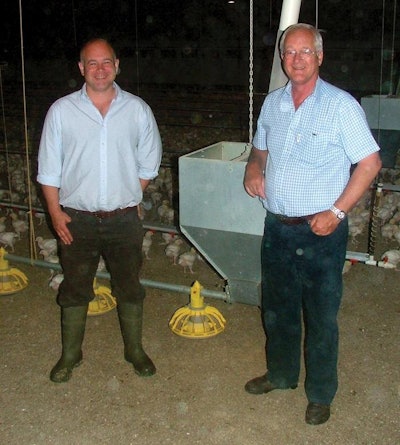
The Joices raise 5.6 million broilers per year, and the resultant litter provides almost all the heat needed for their 16 broiler houses.
Attention to detail
“Our sheds are spotless,” says Nigel. “Total viable swab counts are taken in five places throughout the poultry houses, and they usually come back below 10. We are operating within the top 2-3 percent of U.K. poultry producers where hygiene is concerned.”
And the role of good staff is not underestimated at Uphouse, as evidenced by the new worker housing built on-site.
“When I started, there were tithe cottages on the farm with terrible facilities. Now, however, there are new houses for staff, traditionally built, with top quality facilities and en-suite bathrooms. These have proved their worth. If you want to top staff, you have to reward them,” Nigel says.
The most recent investment has been in a new computer system, which allows ever greater attention to be paid to key performance criteria.
Patrick says: “I now have more data, allowing me to work more closely with vets and feed companies. It is not so different from what we were doing before, but it is more detailed and much better.”
To learn more about on-farm energy generation, read:
UK pullet producer sees business benefits of careful planning


